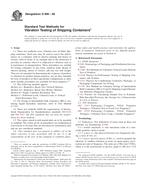Potřebujeme váš souhlas k využití jednotlivých dat, aby se vám mimo jiné mohly ukazovat informace týkající se vašich zájmů. Souhlas udělíte kliknutím na tlačítko „OK“.
ASTM D999-08
Standard Test Methods for Vibration Testing of Shipping Containers
Automaticky přeložený název:
Standardní zkušební metody pro testování vibrací přepravních obalů
NORMA vydána dne 1.8.2008
Informace o normě:
Označení normy: ASTM D999-08
Poznámka: NEPLATNÁ
Datum vydání normy: 1.8.2008
Kód zboží: NS-40058
Počet stran: 5
Přibližná hmotnost: 15 g (0.03 liber)
Země: Americká technická norma
Kategorie: Technické normy ASTM
Anotace textu normy ASTM D999-08 :
Keywords:
repetitive shock, resonance, shipping container, stack resonance, vibration, Repetitive shock, Resonances, Shipping containers/materials/applications, Shock test--shipping containers, Stack resonance, Vibration resistance, Vibration test--packaging/shipping materials, ICS Number Code 55.040 (Packaging materials and accessories)
Doplňující informace
| Significance and Use | ||||||||||||
|
Shipping containers are exposed to complex dynamic stresses when subjected to vibration present in all transportation vehicles. Approximating the actual damage, or lack of damage, experienced in shipping may require subjecting the container(s) and contents to vibration inputs. Resonant responses during shipment can be severe and may lead to package or product failure. Identification of critical frequencies, and the nature of package stresses can aid in minimizing the effect of these occurrences. Vibration tests should be based on representative field data. When possible, the confidence level may be improved by comparing laboratory test results with actual field shipment data. It is highly recommended that one understand the most common failures to one’s products and packaging in distribution, and then attempt to replicate those failures in the laboratory. Once such replication is established, then that test can become the minimum necessary test for future packaged products to pass. Exposure to vibration can affect the shipping container, its interior packaging, means of closure, and contents. These tests allow analysis of the interaction of these components. Design modification to one or more of these components may be utilized to achieve optimum performance in the shipping environment. Methods A1 and A2, Repetitive Shock Tests, are suitable for tests of individual containers that are transported unrestrained on the bed of a vehicle and may be suitable for tests of containers that might be subjected to repetitive shocks due to magnification of vibrations in unit loads or stacks. Note 1—Methods A1 and A2 produce different vibration motions, and therefore, will generate different forces which may result in different damage modes and intensities. Results from these two methods may not correlate with one another. Method B, Single Container Resonance Test, tests or determines the ability of an individual container and its interior packaging to protect the contents from transportation vibration, particularly when the container and its contents might exhibit resonant responses. Note 2—Individual products that are palletized might be better tested using Method C. Method C, Palletized Load, Unitized Load or Vertical Stack Resonance Test, covers the determination of the presence and the effects of resonance in palletized loads and multiple-unit stacked loads, and whether or not the strength of the containers is sufficient to withstand dynamic loads when stacked. Any or all of these test methods may be employed, as determined by the appropriate performance specification, with test intensities, frequency ranges, and test durations as called for in the specification. Although these tests do not simulate the shipping environment, they are intended to create the damage-producing potential of the shipping environment. Results of any one of these methods may differ from the results of the others. |
||||||||||||
| 1. Scope | ||||||||||||
|
1.1 These test methods cover vibration tests of filled shipping containers. Such tests may be used to assess the performance of a container, with its interior packing and means of closure, both in terms of its strength and of the protection it provides its contents when it is subjected to vibration such as it experiences in transportation. These procedures are suitable for testing containers of any form, material, kind, design of interior packing, means of closure, and any size and weight. They are not intended for determining the response of products to vibration for product design purposes, nor are they intended for tests of products in their operational configuration as other more suitable procedures are available for these purposes. , 1.2 The following methods appear: 1.3 For testing of intermediate bulk containers (IBCs) containing liquid hazardous materials, refer to Test Method D 7387. 1.4 These test methods fulfill the requirements of International Organization for Standardization standards ISO 8318 and ISO 2247. The ISO standards may not meet the requirements for these methods. 1.5 The values stated in inch-pound units are to be regarded as standard. The values given in parentheses are mathematical conversions to SI units that are provided for information only and are not considered standard. 1.6 This standard does not purport to address all of the safety concerns, if any, associated with its use. It is the responsibility of the user of this standard to establish appropriate safety and health practices and determine the applicability of regulatory limitations prior to use. Specific precautionary statements are given in Section 6. |
||||||||||||
| 2. Referenced Documents | ||||||||||||
|




 Cookies
Cookies
